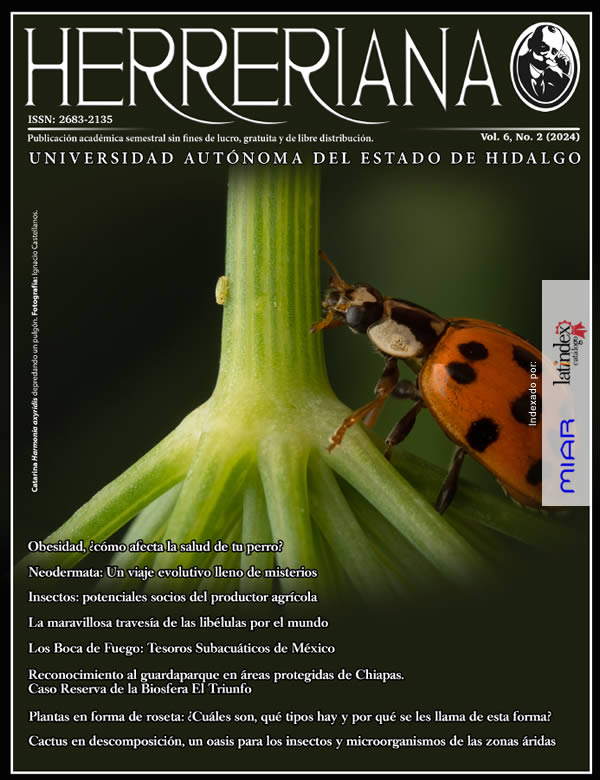Neodermata: An evolutionary journey full of mysteries
Abstract
Neodermata are parasitic flatworms that have a crucial role in public and veterinary health issues. Although much has been researched about them, many aspects of their evolutionary history remain a mystery. Traditional research is based on their anatomy, but with technological advancements, DNA analysis has uncovered new connections between different species. These parasites are divided into three main classes: Monogenea, Trematoda, and Cestoda. Each has unique adaptations that allow them to thrive in their respective environments and hosts. The hypotheses about their evolutionary roots are diverse and continue to be discussed. These parasites are astounding examples of adaptation and evolution, and their study is relevant for the development of antiparasitic treatments.
Downloads
References
Caña-Bozada, V. H., Robinson, M. W., Hernández-Mena, D. I. y Morales-Serna, F. N. (2023). Exploring Evolutionary Relationships within Neodermata Using Putative Orthologous Groups of Proteins, with Emphasis on Peptidases. Tropical Medicine and Infectious Disease, 8 (1), 59. https://doi.org/10.3390/tropicalmed8010059
Lefèvre, T., Lebarbenchon, C., Gauthier-Clerc, M., Missé, D., Poulin, R. y Thomas, F. (2009). The ecological significance of manipulative parasites. Trends in Ecology & Evolution, 24 (1), 41-48. https://doi.org/10.1016/j.tree.2008.08.007
Littlewood, D. T. J., Rohde, K., Bray, R. A. y Herniou, E. A. (1999a). Phylogeny of the Platyhelminthes and the evolution of parasitism. Biological Journal of the Linnean Society, 68 (1-2), 257-287. https://doi.org/10.1111/j.1095-8312.1999.tb01169.x
Littlewood, D. T. J., Rohde, K. y Clough, K. A. (1999b). The interrelationships of all major groups of Platyhelminthes: phylogenetic evidence from morphology and molecules. Biological Journal of the Linnean Society, 66 (1), 75-114. https://doi.org/10.1111/j.1095-8312.1999.tb01918.x
Lockyer, A. E., Olson, P. D. y Littlewood, D. T. J. (2003). Utility of complete large and small subunit rRNA genes in resolving the phylogeny of the Neodermata (Platyhelminthes): implications and a review of the cercomer theory. Biological Journal of the Linnean Society, 78 (2), 155-171. https://doi.org/10.1046/j.1095-8312.2003.00141.x
Park, J. K., Kim, K. H., Kang, S., Kim, W., Eom, K. S. y Littlewood, D. T. J. (2007). A common origin of complex life cycles in parasitic flatworms: evidence from the complete mitochondrial genome of Microcotyle sebastis (Monogenea: Platyhelminthes). BMC Evolutionary Biology, 7 (11), 1-13. https://doi.org/10.1186/1471-2148-7-11
Perkins, E. M., Donnellan, S. C., Bertozzi, T. y Whittington, I. D. (2010). Closing the mitochondrial circle on paraphyly of the Monogenea (Platyhelminthes) infers evolution in the diet of parasitic flatworms. International Journal for Parasitology, 40 (11), 1237-1245. https://doi.org/10.1016/j.ijpara.2010.02.017
Thomas, F. y Poulin, R. (1998). Manipulation of a mollusc by a trophically transmitted parasite: convergent evolution or phylogenetic inheritance?. Parasitology, 116 (5), 431-436. https://doi.org/10.1017/S003118209800239X
Copyright (c) 2024 Victor Hugo Caña Bozada, Francisco Neptalí Morales-Serna

This work is licensed under a Creative Commons Attribution-NonCommercial-NoDerivatives 4.0 International License.










